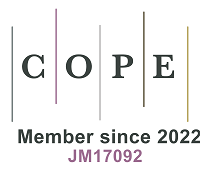REFERENCES
1. Mandalakis, M.; Stephanou, E. G.; Horii, Y.; Kannan, K. Emerging contaminants in car interiors: evaluating the impact of airborne PBDEs and PBDD/Fs. Environ. Sci. Technol. 2008, 42, 6431-6.
2. Saraswat, A.; Kandlikar, M.; Brauer, M.; Srivastava, A. PM2.5 population exposure in new delhi using a probabilistic simulation framework. Environ. Sci. Technol. 2016, 50, 3174-83.
3. Ma, X.; Longley, I.; Gao, J.; Salmond, J. Evaluating the effect of ambient concentrations, route choices, and environmental (in)justice on students’ dose of ambient NO2 while walking to school at population scales. Environ. Sci. Technol. 2020, 54, 12908-19.
4. Künzli, N.; Kaiser, R.; Medina, S.; et al. Public-health impact of outdoor and traffic-related air pollution: a European assessment. Lancet 2000, 356, 795-801.
5. Garcia, L.; Johnson, R.; Johnson, A.; et al. Health impacts of changes in travel patterns in Greater Accra Metropolitan Area, Ghana. Environ. Int. 2021, 155, 106680.
6. Beelen, R.; Hoek, G.; van den Brandt, P. A.; et al. Long-term effects of traffic-related air pollution on mortality in a Dutch cohort (NLCS-AIR study). Environ. Health. Perspect. 2008, 116, 196-202.
7. Celis-Morales, C. A.; Lyall, D. M.; Welsh, P.; et al. Association between active commuting and incident cardiovascular disease, cancer, and mortality: prospective cohort study. BMJ 2017, 357, j1456.
8. Nordling, E.; Berglind, N.; Melén, E.; et al. Traffic-related air pollution and childhood respiratory symptoms, function and allergies. Epidemiology 2008, 19, 401-8.
9. Aziz, K.; Ali, Z.; Nasir, Z. A.; Colbeck, I. Comparative study of particulate matter in the transport microenvironment (buses) of Pakistan and UK. J. Anim. Plant. Sci. 2015, 25, 636-43. http://dspace.lib.cranfield.ac.uk/handle/1826/14164. (accessed 18 Jul 2025).
10. Brauer, M.; Lencar, C.; Tamburic, L.; Koehoorn, M.; Demers, P.; Karr, C. A cohort study of traffic-related air pollution impacts on birth outcomes. Environ. Health. Perspect. 2008, 116, 680-6.
11. McConnell, R.; Islam, T.; Shankardass, K.; et al. Childhood incident asthma and traffic-related air pollution at home and school. Environ. Health. Perspect. 2010, 118, 1021-6.
12. Min, K. D.; Yi, S. J.; Kim, H. C.; et al. Association between exposure to traffic-related air pollution and pediatric allergic diseases based on modeled air pollution concentrations and traffic measures in Seoul, Korea: a comparative analysis. Environ. Health. 2020, 19, 6.
13. Ma, X.; Longley, I.; Gao, J.; Kachhara, A.; Salmond, J. A site-optimised multi-scale GIS based land use regression model for simulating local scale patterns in air pollution. Sci. Total. Environ. 2019, 685, 134-49.
14. Forehead, H.; Huynh, N. Review of modelling air pollution from traffic at street-level - The state of the science. Environ. Pollut. 2018, 241, 775-86.
15. Singh, V.; Meena, K. K.; Agarwal, A. Travellers’ exposure to air pollution: a systematic review and future directions. Urban. Climate. 2021, 38, 100901.
16. Goel, R.; Gani, S.; Guttikunda, S. K.; Wilson, D.; Tiwari, G. On-road PM2.5 pollution exposure in multiple transport microenvironments in Delhi. Atmos. Environ. 2015, 123, 129-38.
17. Harrad, S.; Hazrati, S.; Ibarra, C. Concentrations of polychlorinated biphenyls in indoor air and polybrominated diphenyl ethers in indoor air and dust in Birmingham, United Kingdom: implications for human exposure. Environ. Sci. Technol. 2006, 40, 4633-8.
18. Abdillah, S. F. I.; You, S. J.; Wang, Y. F. Characterizing sector-oriented roadside exposure to ultrafine particles (PM0.1) via machine learning models: Implications of covariates influences on sectors variability. Environ. Pollut. 2024, 359, 124595.
19. Yang, F.; Kaul, D.; Wong, K. C.; et al. Heterogeneity of passenger exposure to air pollutants in public transport microenvironments. Atmos. Environ. 2015, 109, 42-51.
20. Borghi, F.; Spinazzè, A.; Fanti, G.; et al. Commuters’ personal exposure assessment and evaluation of inhaled dose to different atmospheric pollutants. Int. J. Environ. Res. Public. Health. 2020, 17, 3357.
21. de Kluizenaar, Y.; Kuijpers, E.; Eekhout, I.; et al. Personal exposure to UFP in different micro-environments and time of day. Build. Environ. 2017, 122, 237-46.
22. Dons, E.; Int Panis, L.; Van Poppel, M.; Theunis, J.; Wets, G. Personal exposure to Black Carbon in transport microenvironments. Atmos. Environ. 2012, 55, 392-8.
23. Dons, E.; Int Panis, L.; Van Poppel, M.; et al. Impact of time-activity patterns on personal exposure to black carbon. Atmos. Environ. 2011, 45, 3594-602.
24. Shafran-Nathan, R.; Yuval,
25. Rind, E.; Shortt, N.; Mitchell, R.; Richardson, E. A.; Pearce, J. Are income-related differences in active travel associated with physical environmental characteristics? A multi-level ecological approach. Int. J. Behav. Nutr. Phys. Act. 2015, 12, 73.
26. Watson, K. B.; Whitfield, G. P.; Bricka, S.; Carlson, S. A. Purpose-based walking trips by duration, distance, and select characteristics, 2017 National Household Travel Survey. J. Phys. Act. Health. 2021, 18, S86-93.
27. Gong, W.; Yuan, F.; Feng, G.; et al. Trends in transportation modes and time among Chinese population from 2002 to 2012. Int. J. Environ. Res. Public. Health. 2020, 17, 945.
28. D’Agostino, E. M.; Armstrong, S. C.; Alexander, E. P.; Østbye, T.; Neshteruk, C. D.; Skinner, A. C. Predictors and patterns of physical activity from transportation among United States Youth, 2007-2016. J. Adolesc. Health. 2021, 69, 263-71.
29. Liu, X.; Gao, L.; Ni, A.; Ye, N. Understanding better the influential factors of commuters’ multi-day travel behavior: evidence from Shanghai, China. Sustainability 2020, 12, 376.
30. Branion-Calles, M.; Teschke, K.; Koehoorn, M.; Espin-Garcia, O.; Harris, M. A. Estimating walking and bicycling in Canada and their road collision fatality risks: the need for a national household travel survey. Prev. Med. Rep. 2021, 22, 101366.
31. Yang, Y.; Wang, C.; Liu, W.; Zhou, P. Understanding the determinants of travel mode choice of residents and its carbon mitigation potential. Energy. Policy. 2018, 115, 486-93.
32. Nguyen-Phuoc, D. Q.; Amoh-Gyimah, R.; Tran, A. T. P.; Phan, C. T. Mode choice among university students to school in Danang, Vietnam. Travel. Behav. Soc. 2018, 13, 1-10.
33. Li, J.; Lo, K.; Guo, M. Do Socio-economic characteristics affect travel behavior? A comparative study of low-carbon and non-low-carbon shopping travel in Shenyang City, China. Int. J. Environ. Res. Public. Health. 2018, 15, 1346.
34. Yu, C. Y.; Lin, H. C. Exploring factors regarding transit-related walking and walking duration. J. Phys. Act. Health. 2016, 13, 1220-9.
35. Greaves, S. P. Capturing the spatiotemporal variability of fine particulates in travel microenvironments using GPS technology. In Proceedings of the 12th International Conference on Urban Transport and the Environment in the 21st Century, Prague, Czech republic. Jul 12-14, 2006. pp. 849-58.
36. Mitsakou, C.; Adamson, J. P.; Doutsi, A.; et al. Assessing the exposure to air pollution during transport in urban areas - evidence review. J. Transp. Health. 2021, 21, 101064.
37. Kaur, S.; Nieuwenhuijsen, M.; Colvile, R. Fine particulate matter and carbon monoxide exposure concentrations in urban street transport microenvironments. Atmos. Environ. 2007, 41, 4781-810.
38. Miao, Q.; Bouchard, M.; Chen, D.; Rosenberg, M. W.; Aronson, K. J. Commuting behaviors and exposure to air pollution in Montreal, Canada. Sci. Total. Environ. 2015, 508, 193-8.
39. Suárez, L.; Mesías, S.; Iglesias, V.; Silva, C.; Cáceres, D. D.; Ruiz-Rudolph, P. Personal exposure to particulate matter in commuters using different transport modes (bus, bicycle, car and subway) in an assigned route in downtown Santiago, Chile. Environ. Sci. Process. Impacts. 2014, 16, 1309-17.
40. Tsai, D. H.; Wu, Y. H.; Chan, C. C. Comparisons of commuter’s exposure to particulate matters while using different transportation modes. Sci. Total. Environ. 2008, 405, 71-7.
41. Adams, H.; Nieuwenhuijsen, M.; Colvile, R.; Older, M.; Kendall, M. Assessment of road users’ elemental carbon personal exposure levels, London, UK. Atmos. Environ. 2002, 36, 5335-42.
42. Wu, D.; Lin, M.; Chan, C.; et al. Influences of commuting mode, air conditioning mode and meteorological parameters on fine particle (PM2.5) exposure levels in traffic microenvironments. Aerosol. Air. Qual. Res. 2013, 13, 709-20.
43. Jiang, N.; Qi, L.; Wang, B.; et al. Traffic related activity pattern of Chinese adults: a nation-wide population based survey. J. Expo. Sci. Environ. Epidemiol. 2023, 33, 482-9.
44. Wu, L.; Wang, W.; Jing, P.; et al. Travel mode choice and their impacts on environment - a literature review based on bibliometric and content analysis, 2000-2018. J. Clean. Prod. 2020, 249, 119391.
45. Feng, J.; Dijst, M.; Wissink, B.; Prillwitz, J. Changing travel behaviour in urban China: evidence from Nanjing 2008-2011. Transp. Policy. 2017, 53, 1-10.
46. Boniardi, L.; Borghi, F.; Straccini, S.; et al. Commuting by car, public transport, and bike: exposure assessment and estimation of the inhaled dose of multiple airborne pollutants. Atmos. Environ. 2021, 262, 118613.
47. EPA. Exposure factors handbook (2011 edition). https://www.epa.gov/expobox/exposure-factors-handbook-2011-edition. (accessed 18 Jul 2025).
48. Li, Y.; Fan, Z.; Li, K.; Wu, D. Commuter exposure to PM2.5 and its influencing factors in different commuting modes. Environ. Chem. 2015, 34, 1408-16. https://caod.oriprobe.com/articles/46834431/Commuter_exposure_to_PM2_5_and_its_influencing_fac.htm. (accessed 18 Jul 2025).
49. Lanzhou Ecology and Environment Bureau. Report on the State of the Environment. https://sthjj.lanzhou.gov.cn/col/col5758/index.html. (accessed 18 Jul 2025).
50. McNabola, A.; Broderick, B. M.; Gill, L. W. A principal components analysis of the factors effecting personal exposure to air pollution in urban commuters in Dublin, Ireland. J. Environ. Sci. Health. A. Tox. Hazard. Subst. Environ. Eng. 2009, 44, 1219-26.
51. Qiu, Z.; Song, J.; Xu, X.; et al. Commuter exposure to particulate matter for different transportation modes in Xi’an, China. Atmos. Pollut. Res. 2017, 8, 940-8.
52. Goodman, A. Walking, cycling and driving to work in the English and Welsh 2011 census: trends, socio-economic patterning and relevance to travel behaviour in general. PLoS. One. 2013, 8, e71790.
53. Gali, N. K.; Jiang, S. Y.; Yang, F.; Sun, L.; Ning, Z. Redox characteristics of size-segregated PM from different public transport microenvironments in Hong Kong. Air. Qual. Atmos. Health. 2017, 10, 833-44.
54. Duan, X.; Zhao, X.; Wang, B.; Chen, Y.; Cao, S. 5 - Time-activity factors related to air exposure. In Highlights of the Chinese Exposure Factors Handbook (Adults). Academic Press: 2015; pp. 31-9. https://www.researchgate.net/publication/294645842_Highlights_of_the_Chinese_Exposure_Factors_HandbookAdults. (accessed 18 Jul 2025).
55. Zulauf, N.; Dröge, J.; Klingelhöfer, D.; Braun, M.; Oremek, G. M.; Groneberg, D. A. Indoor air pollution in cars: an update on novel insights. Int. J. Environ. Res. Public. Health. 2019, 16, 2441.
56. Jin, H.; Jin, F.; Wang, J.; Sun, W.; Dong, L. Competition and cooperation between shared bicycles and public transit: a case study of Beijing. Sustainability 2019, 11, 1323.
57. Ji, W.; Lu, C.; Mao, J.; Liu, Y.; Hou, M.; Pan, X. Public’s intention and influencing factors of dockless bike-sharing in central urban areas: a case study of Lanzhou City, China. Sustainability 2021, 13, 9265.
58. Campbell, K. B.; Brakewood, C. Sharing riders: how bikesharing impacts bus ridership in New York City. Transp. Res. Part. A. Policy. Pract. 2017, 100, 264-82.
59. Cao, M.; Ma, S.; Huang, M.; Lü, G.; Chen, M. Effects of free-floating shared bicycles on urban public transportation. IJGI 2019, 8, 323.
60. Zhou, X.; Liang, J.; Ji, X.; Cottrill, C. D. The influence of information services on public transport behavior of urban and rural residents. Sustainability 2019, 11, 5454.
61. Lidbe, A.; Adanu, E. K.; Penmetsa, P.; Jones, S. Changes in the travel patterns of older Americans with medical conditions: a comparison of 2001 and 2017 NHTS data. Transp. Res. Interdiscip. Perspect. 2021, 11, 100463.
62. Gascon, M.; Götschi, T.; de Nazelle, A.; et al. Correlates of walking for travel in seven European cities: the PASTA Project. Environ. Health. Perspect. 2019, 127, 97003.
63. Qiu, Z.; Lv, H.; Zhang, F.; Wang, W.; Hao, Y. Pedestrian exposure to PM2.5, BC and UFP of adults and teens: a case study in Xi’an, China. Sustain. Cities. Soc. 2019, 51, 101774.
64. Gilliland, J.; Maltby, M.; Xu, X.; Luginaah, I.; Shah, T. Influence of the natural and built environment on personal exposure to fine particulate matter (PM2.5) in cyclists using city designated bicycle routes. Urban. Sci. 2018, 2, 120.
65. Okokon, E. O.; Yli-Tuomi, T.; Turunen, A. W.; et al. Particulates and noise exposure during bicycle, bus and car commuting: a study in three European cities. Environ. Res. 2017, 154, 181-9.
66. Bigazzi, A. Y.; Figliozzi, M. A. Review of urban bicyclists’ intake and uptake of traffic-related air pollution. Transp. Rev. 2014, 34, 221-45.
67. Hatzopoulou, M.; Weichenthal, S.; Barreau, G.; et al. A web-based route planning tool to reduce cyclists’ exposures to traffic pollution: a case study in Montreal, Canada. Environ. Res. 2013, 123, 58-61.







